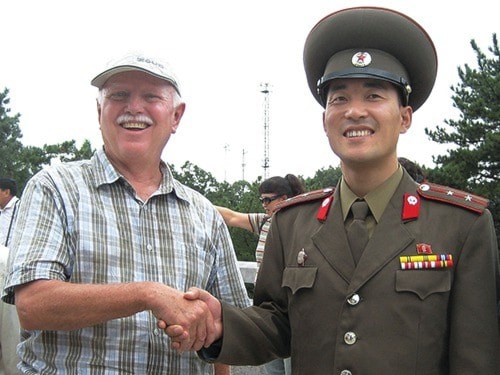A Nanaimo resident who visited North Korea in 2010 says the country he experienced is not the same one that has been portrayed by Western media and governments recently.
David Stanley visited the communist country for two weeks with his wife as part of a personal goal to visit as many United Nation member countries as he can – he has been to 183 out of 194 member countries so far – and to learn more about other cultures.
“The visa for North Korea was about as easy as it gets to apply for,” he said. “In fact, getting the one for China – our tour was out of Beijing – was much harder to get. The application for North Korea was one page and the questions weren’t that difficult.”
It’s much harder for South Korean nationals and media.
Recently, North Korea has been vilified in the Western press because of its increased rhetoric and military provocation toward South Korea and the United States. Part of that aggression has included moving mobile missile launchers to its east coast to conduct tests, a move that has prompted Canada’s foreign affairs department to post severe traveller advisories for North Korea – it is still apparently safe to travel to South Korea, according to the ministry’s website – while the UN has imposed further economic sanctions.
North Korea’s young leader, Kim Jong-un, took over from his late father Kim Jong-il last year.
But Stanley says that while his tour was largely devoid of any politics, except for a visit to the tomb of the country’s first president Kim Il-sung, the North Korea he saw did not include widespread poverty, oppression, starvation, or a Western-hating population.
“I didn’t feel like they were trying to hide anything,” he said. “Now, obviously we were tourists, so they wanted to show us the best of their country and we could only go where they took us, but no, it is not the country we are told about on the evening news. Those reports seem to be very one-sided.”
Restrictions for visitors, however, are heavy. All tourists must be accompanied by a guide at all times when outside their hotel, and they are generally not allowed to talk to people in the streets. No photos were allowed to be taken out of the window of the bus, and in some locations government buildings were not allowed to be photographed.
Stanley said at one point he asked his guide if he could take some photos, and the guide surveyed the landscape and said he could take some in one direction but not the other.
Many of the quirky rules tourists in North Korea face involve photos. People are allowed to have their photo taken in front of the statue of a supreme leader, but are not allowed to assume the same pose and the entire statue must be included in the frame.
When leaving the country, border security edits the photos thoroughly, though Stanley said he doesn’t believe any of his were deleted.
One of the more disturbing situations he came across however, occurred while travelling on the bus from one hotel to another near the border. The North Korean military had erected a fence along a beach and along the fence was a strip of sand.
“The sand is finely raked every day,” said Stanley. “We were told it was to detect people coming into the country, potential invaders – it was pretty obvious it was to detect people trying to leave – but my biggest issue is that the people couldn’t go to the beach. It was things like that that raised my eyebrows.”
The geography of North Korea is largely mountainous, and many photos Stanley brought home show beautiful waterfalls, large plains backed by heavily forested hills and quaint countryside.
In the cities, including the capital Pyongyang, massive grey communist-era apartments are interspersed with stunning architecture of government and arts buildings, as well as traditional Korean architecture. Parks and green spaces are prevalent, as are large squares used for public ceremonies and military parades.
Food, said Stanley, is not as much to his taste as other places, but there didn’t appear to be a shortage.
“One night we were to get on a bus and go to a restaurant four or five blocks away,” he said.
“Our group asked if we could walk. After lengthy consideration we were allowed to, and along the way I peered into every shop I could. There were plenty of things for sale. And one thing that struck me is that they try to grow food just about everywhere, along roadways and medians, everywhere. There is no shortage of food, though I can’t say it was good.”
However, in 2008 the United Nations World Food Program estimated that about nine million North Koreans were in need of food aid, and last year 60 per cent of North Korean households were rationing food portions.
Despite North Korea’s current aggressive rhetoric, tourism in the country is on the increase with many tours operating out of the U.K., including Regent Holidays, which hosted the Stanleys.
According to one report, an estimated 2,000 Westerners visit North Korea annually, with demand rising each year.
“It’s not for everybody,” said Stanley. “If you’re looking for a beach and shopping, you’ll probably be disappointed. But for us it was something different, and we never felt threatened or uneasy.”
